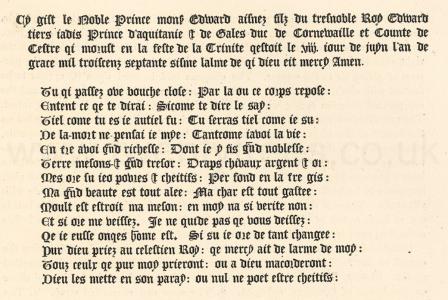Armour
Armour is in Church Monument Details.
Culture, General Things, Church Monuments, Church Monument Details, Armour, Aillettes
Aillettes are an early form of shoulder protection being flat pieces of, typically, boiled leather.
Around 1325. Monument to an unknown member of the de Vere Family in St Michael & All Angels Church, Great Tew [Map] notable for the armour having Aillettes. Right Leg over Left. Early Medieval Period.
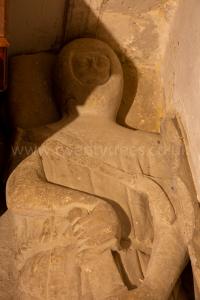
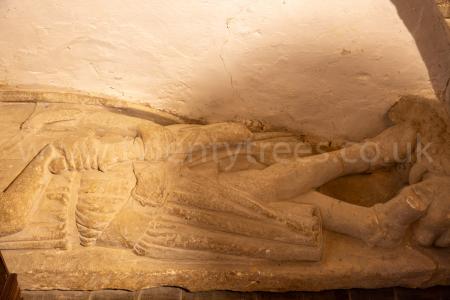
Culture, General Things, Church Monuments, Church Monument Details, Armour, Bevor
Bevor. Plate armour designed to protect the lower face and neck. Derived from the French 'baver' meaning to dribble.
Culture, General Things, Church Monuments, Church Monument Details, Armour, Gambeson
Gambeson, aka Aketon aka Aqueton aka Wambais. A padded defensive jacket, worn as armour separately, or combined with mail or plate armour. Probably made of linen or cotton, stuffed with wool or tow ie unworked linen fibres.
Introduction. On the subject of plate and mail armour, Mr. Stothard himself makes the following remarks, in a letter addressed to that eminent antiquary, the late Rev. Thomas Kerrich: "It is, I believe, a most difficult thing to say when plate-armour was first introduced, because no representations, however well executed, can tell us of what was worn out of sight, and inventories of armour, as well as notices of writers on the subject, are not common; the only things by which we can gain information. Daniel, in his 'Military Discipline of France' cites a poet who describes a combat between William de Barres and Richard Coeur de Lion (then Earl of Poitou), in which he says, that they met so fiercely that their lances pierced through each other's coat of mail and gambeson, but were resisted by a plate of wrought-iron worn beneath. This is a very solitary piece of information; and the poet cited (whose name, I believe, is not mentioned) might not have been contemporary with the event described, and of course gave the custom of his own time. It however strikes me, that plate was at all times partially used. We find in the reign of Henry the Third pieces of plate on the elbows and knees. I have a drawing from a figure about the time of Edward the First, in mail, with gauntlets of plate; and I strongly suspect that a steel cap was worn under the mail oftener than we imagine. How can we otherwise account for the form in the mail chaperon of William Longespee? Would not the top of the head be round instead of flat, if something were not interposed to give it this form? And how ill calculated to receive a blow, supposing nothing but the mail and linen coif interposed. See the effigy in No. 8. of my work, from Hitchendon churcha: where a piece of mail appears cut out, does it not seem that there is a cap beneath the mail?
Note a. The effigy of Richard Wellesburne de Montfort.
Introduction. "But, to dwell longer on this head, plate-armour appears, from our paintings in MSS. and monuments, not to have gained any ground till the fifth or sixth of Edward the Third. John of Eltham and the Knight at Ifield, with Sir John Dabernoun, are the first specimens. Yet to show how careful we should be on this point, we find, in an account taken 1313, the sixth of Edward II. of the armour which belonged to Piers Gaveston, the following items: 'A pair of plates (these covered the body, and most probably were the back and breast plate), rivetted and garnished with silver, with four chains of silver, (see for chains the effigy of the Blanchfront,) covered with red velvet, besanted with gold. Two pair of jambers (armour for the legs) of iron, old and new; two coats of velvet to cover the plates.' All the monumental figures I ever saw, of the time of Edward the Second, have been in mail, as far as I could judge; so that you see I am in some difficulty. I am not surprised that mail was not so much worn after the introduction of plate; considering how the body then became loaded, it was necessary to get rid of something. On the Knight at Ifield, and Sir John Dabernouna, we may see first the thick quilted gambeson, over which is the haubergeon of mail, having above that what I take to be the If there was any plate on the body, it was hidden by the surcoat, which went over all; but there is reason to suspect there was: for, in the profile of the Ash Church Effigy, we see between the lacings of the surcoat that the body is covered with narrow plates. After the introduction of plate-armour the gambeson first disappears; which was followed by the aqueton. The aqueton is seen without the gambeson in Sir Oliver Ingham: it is blue, with gold studs or points.
Note a. See the figures referred to by Mr. Stothard in these observations, delineated in the work.
Introduction. Those whose property did not qualify them to become knights, and wear the distinction of the knightly order, the hauberk of mail, were to supply themselves with a quilted gambeson, or wambais, as a defence:
"Quicumque vero 20 librarum vel amplius habebit de mobilibus, tenebitur habere loricam, vel loricale et capellum ferreum et lanceam. Qui vero minus de 20 libris habebit de mobilibus, tenebitur habere et capellum ferreum et lanceam." [But whosoever shall have 20 pounds or more of movables, must have a belt, or a breastplate and an iron hat and a lance. But he who will have less than 20 pounds of movables, he must have both an iron hat and a lance]
Effigy of Richard Wellesburne de Montfort. THIS very remarkable effigy lies on the north wall of the church of Hitchendon in Buckinghamshire. After the battle of Evesham in 1265, in which the famous Baron Simon de Montfort, with his eldest son Henry, lost their lives, his wifea and children fled the country, with the exception of the youngest son Richard, who assumed the name of Wellesburne (from a manor so termed in Warwickshire, an ancient possession of the family), and retired to Hinchendon as above, where he resided at a mansion called Wreck Hall. The armorial bearings on this effigy, and the peculiarities which mark the period of its execution, enable us very confidently to appropriate it to this identical personage. He became the founder of the family of Wellesburne, which was extant in the county of Buckingham, in the reign of Henry VI. In the church of Hitchendon down to that period were placed numerous monuments of his successors, one of which will be found in another place. A deed of this Wellesburne de Montfort has been printed in Nichols's History of Leicestershire, the faulty Latin of which is perhaps no proof of its being fictitious. There are two seals appended to this instrument, one of which has the legend "Sigillum Bellatoris, filii Simonis de Montefort; [Seal of the Warrior, son of Simon de Montefort]" the other bears the rampant lion of his house, the legend "Wellisburne de la Monteforte."

There is some reason to conjecture that Richard Wellesburn de Montfort was imbued with the martial character of his race. His effigy represents him in the attitude of a Crusader (he might, not improbably, have passed some of the years immediately after his father's overthrow, abroad, in the service of the cross); his right hand grasps a dagger, his left sustains a ponderous broad-bladed sword, on the scabbard of which are escutcheons of various armorial coats, borne doubtless by the connections of his noble family. On this and all the effigies of his descendants the pride of heraldry obtains, which shows that they resigned not, under adverse fortune and a change of name, the remembrance of their honours.
The quilted gambeson appears in bold folds under the hauberk and descends to the upper part of the knee. His feet rest on a lion, on which is a crescent for difference. The bearing of the shield is very remarkable; a lion rampant à la queue fourchée, holding in his mouth a childb the field semée with crosslets fitchée. The bearing is repeated on the surcoat quarterly, with a griffin segreant, holding in his paws a child, and with the addition of a chief cheque, no doubt for Mellent, to which Earldom the Montforts succeeded about the time of the Norman Conquest.
This effigy is executed in a truly noble style, and recalls to us at a glance the age of chivalry and romantic feeling; and it is somewhat remarkable, that it commemorates a name which has become hacknied among the writers of fiction, without allusion to the historic tacts connected with it, merely for its sound. The slender but striking circumstances which are known concerning Wellesburne de Montfort surely afford admirable ground-work for the writer of historical romance.
Note a. Eleanor, second daughter of King John and Isabella of Angoulesme, she retired to a nunnery at Montargis, in France. Simon her second son, was Count of Bigorre in France, where he founded a family bearing his patrimonial name; Almaric, her third son, was first a priest in York, but embraced the military profession abroad; Guy, the fourth son, was Count of Anglezia in Italy, progenitor of the Montforts of Tuscany, and of the Counts of Campobachi in Naples; Richard, the fifth son, is commemorated by the effigy.
Note b. Gules, a Hon rampant with two tails argent, was a bearing of Simon de Montfort, Earl of Leicester. See the vignette above, from an architectural decoration in Westminster Abbey. This shield with the addition of a child in the lion's mouth, was blazoned in the windows of Wreck Hall at Hitchendon, and carved on the reading desk of Hitchendon Church. Argent, a lion rampant, with ten cross-crosslets fitchée sable, are the Montforts of Warwickshire. Bendy of six. Or and Gules, changed temp. Edward 1. to bendy of ten, are the Montforts of Beldesert. Gules, a griffin segreant, a chief cheque Or and Azure, over all a bend Ermine, is a coat of the Wellesburn Montforts. There is at Hitchendon a monumental figure of a withered corpse, enshrouded in a loose shirt, having marked on his breast the figure of a priest and eight crosslets on his body. This represents, it may be well conjectured, some incumbent of the parish church of the Montfort family. Langley conceives (but the style of the figure by no means supports the idea) that it is a memorial for Peter, son of Peter de Montfort, who died at the battle of Evesham. See Hist, of Desborough Hundred, p. 478.
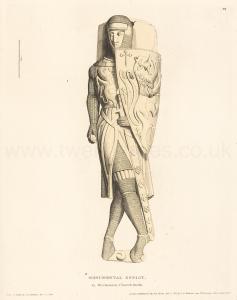
Time Team Series 2 Episode 1: Lord of the Isles was filmed between 24 Jun 1994 and 26 Jun 1994 was filmed. It was originally shown on 08 Jan 1995.
Location: Finlaggan, Islay [Map]
Category: Time Team Prehistory, Time Team Early Medieval.
The Time Team:
Tony Robinson (age 48), Presenter
Mick Aston (age 48), Bristol University Landscape Archaeologist
Carenza Lewis (age 31), Royal Commission on Historic Monuments
Phil Harding (age 44), Wessex Archaeological Trust Field Archaeologist
Robin Bush (age 51), Archivist
Victor Ambrus (age 59), Historical Illustrator
John Gator, Chris Gaffney, Geophysics
Stewart Ainsworth (age 43), Landscape Archaeologist
David Caldwell, Director of Excavations
Kate Bonner, Excavation Team
Sally Ann Chandler, Period Clothing Expert
Donald Macfadian, Finlaggan Trust
Simon Mears, GPS System
Historical Figures: King Somerled of Argyll
Sources: Chronicle of Man and the Isles, A Description of the Western Isles of Scotland by Martin Martin, A Description of the Western Isles of Scotland by Martin Martin.
Outcomes: Partly complete Glass Bead, Replica aketon, possible mesolithic site, possibly stone rows aligned to Paps of Jura.
Culture, General Things, Church Monuments, Church Monument Details, Armour, Gauntlets
Culture, General Things, Church Monuments, Church Monument Details, Armour, Jupon
Jupon aka surcoat. A heavily padded jacket affording additional protection to the shoulders, upper arms, torso and upper legs. The bottom of the jupon was often decorated, sometimes roundels, sometimes scallops. The jupon was sometimes decoated with Knight's Arms becoming, literally, a Coat of Arms
Around 1340 the Camail and Jupon Period starts; around the time of the commencement of the Hundred Years War. Knights wear a bascinet with camail and a jupon. The Camail and Jupon Period is also characterised by the heavy belts slung low on the hips from which the sword was slung. Effigies of this period are characterised by having facial hair, and their hands clasped in prayer on the chest. Male effigies of this period have their head resting on Great Helms usually surmounted by their Crest.
After 10 Jul 1359. Monument to William Greystoke 2nd Baron Greystoke (deceased) in St Andrew's Church, Greystoke [Map]. Camail and Jupon Period. On his head he wears the bascinet with a camail. The jupon under which his coat of chain mail may be seen. His sword belt is low on his jupon, horizontal.
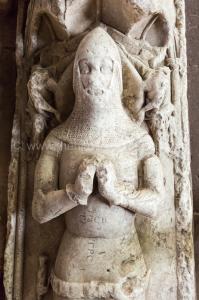
On 26 Jul 1375 Richard Pembridge (age 55) died. Hereford Cathedral [Map]. Alabaster altar-tomb and effigy, altar-tomb with moulded base and capping, sides and ends panelled with alternate quatrefoils enclosing shields of his arms and trefoil-headed panels; effigy in bascinet, Camail and Jupon Period. His jupon with same arms as his shield. Hip Belt, Leg Garter, right leg modern, head on helm crested with a Feathered Crest, feet on hound.
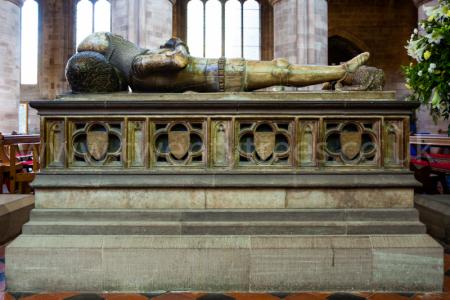
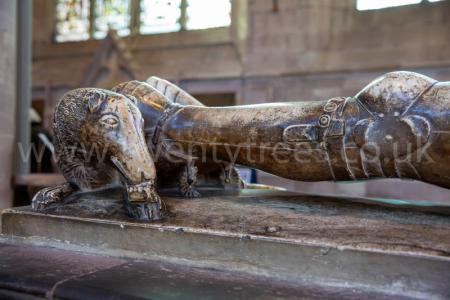
In 1436 John Greystoke 4th Baron Greystoke (age 47) died. He was buried at St Andrew's Church, Greystoke [Map]. His son Ralph Greystoke 5th Baron Greystoke (age 22) succeeded 5th Baron Greystoke. Monument in St Andrew's Church, Greystoke [Map]. Fluted Period. His Pauldrons are unusual in their style. His arms are fully encased in plate with a couter (or coude) protecting the elbow joint. Fine detail of the straps that held the armour in place may be seen on the underarms. A gorget, has replaced the camail. His head is, very unusually, bare as is his face, his hair cut in the style so typical of portraits of Henry V. The effigy was possibly made somewhat after John's death or, possibly, that the effigy has been incorrectly assigned. His head rests on the decorated tournament helm. He wears the Lancastrian Esses Collar. John had supported the usurpation of Richard II by Henry IV in the 1390s; staunch Lancastrians. John had married, in 1407, Elizabeth Ferrers, daughter of Joan Beaufort, daughter of John of Gaunt, son of King Edward III. Two sword belts: diagonal (bawdric) and horizontal. The jupon, beneath the waist has been replaced by a fauld; horizontal strips of metal that wrap around.
John Greystoke 4th Baron Greystoke: In 1389 he was born to Ralph Greystoke 3rd Baron Greystoke and Catherine Clifford Baroness Greystoke. On 28 Oct 1407 John Greystoke 4th Baron Greystoke and Elizabeth Ferrers Baroness Greystoke were married at Greystoke Castle, Cumberland. She by marriage Baroness Greystoke. She the daughter of Robert Ferrers and Joan Beaufort Countess of Westmoreland. She a great granddaughter of King Edward III of England. On 06 Apr 1418 Ralph Greystoke 3rd Baron Greystoke died. He was buried at Newminster Abbey. His son John Greystoke 4th Baron Greystoke succeeded 4th Baron Greystoke.
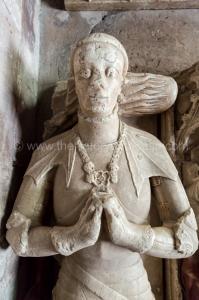
Culture, General Things, Church Monuments, Church Monument Details, Armour, Reticulated
Reticulated. Constructed, arranged, or marked like a net.
Effigy of William of Windsor and Blanche de la Tour. EDWARD gave another of his sons by Philippa the name of William, who died so young that nothing more is known of him than the place of his birth, as affixed to his name, and that he was buried at Westminster, in the chapel of St. Edmund [Map], in the abbey church. In the same tomb are also deposited the remains of Blanch de la Tour, their third daughter, so called from her birthplace, the Tower of London [Map]. She was born and died in 1340. Their effigies in alabaster, scarcely eighteen inches in length, are placed on an altar-tomb. Sandford says that an inscription on brass, which had been affixed on the monument, was not extant in his time. The costume of the male figure much resembles that of William of Hatfield. The cote hardie of the female, flanches, jewelled stomacher, girdle, cordon and clasps of the mantle, are worthy attention.
Details. Plate 1. One of the fermails of the Princess's mantle. Plate II. Ornaments on the Prince's girdle. Plate III. Details of the Princess's circlet and reticulated head-dress.
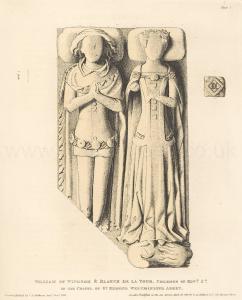

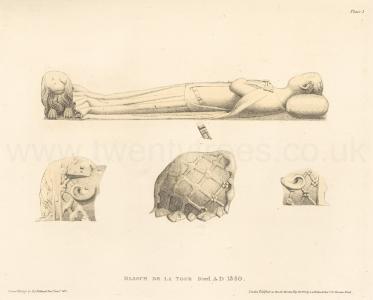
Effigy of Joam Burwaschs, Lady Mohun. The attire of the Lady Mohun presents us with an example of the fret or reticulated coiffure adopted by court ladies of the fourteenth century; and of the cote hardie, which appears to have been a vestment fitting close to the body, leaving the neck bare, and became much in vogue with the ladies towards the latter end of the fourteenth century. The wimpled attire of Aveline Countess of Lancaster will shew how chary they were of their charms in the preceding age. The wimpled costume seems, indeed, to have been borrowed from the females of the East. Mr. Charles Stothard relates a humorous anecdote of a damsel who wore the cote hardie in one of his original letters inserted in the Memoir of his Lifea.
Details. Plate 1. Jewelled lace on the hips of the cote hardie. Plate II. 1. Top of the coiffure. 5. Portion of the circlet enlarged. 3. Reticulation of the coiffure. 4. Pattern on the cote hardie.
Note a. Memoirs including Original Letters, &c. of C. A. Stothard, F. S. A. by Mrs. Charles Stothard. London, 3823, p. 331.
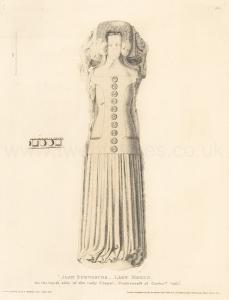
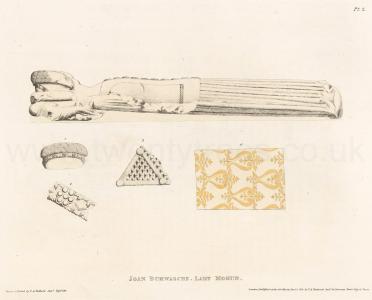
Culture, General Things, Church Monuments, Church Monument Details, Armour, Sallet
Culture, General Things, Church Monuments, Church Monument Details, Armour, Vervelles
Introduction. "The basinet was worn in the fourteenth century, and part of the thirteenth, sometimes with or without a vizor, but always finished with other appendages, as vervillesa. The camail, and what was called by the French a hourson, to which may be added a strap, was to attach the whole, by means of a buckle, to the haubergeon, or plates.
Note a. Memoir, p. 335.
Effigy of Edward, the Black Prince. The Prince's Tomb is not in the Lady Chapel, as ordered in the Will, but on the south side of the Chapel of the Holy Trinity. In other respects it nearly agrees with the above order. The Tomb is of Sussex marble, divided into sixteen quatrefoiled panels, six on each side, two at the head, and two at the foot of the Tomb, in each of which are fixed escutcheons of copper, enamelled alternately with the arms and badges of the Black Prince. Above those, with the arms, is engraved on scrolls of copper, HOUMONT; and above those, with the badges in a similar manner, ICH DIENE. The effigy is of copper gilt, and lies upon the Tomb on a table of the same metal: it represents the Black Prince in armour, his head resting on his helmet, on which is the chapeau surmounted by a leopard crowned, having a file of three points about his neck. The countenance of the Prince possesses fine character. He is represented with long mustachios, which fall on each side over the camail, with which his face is closely enveloped; his beard is almost entirely concealed. On the bacinet is a rich coronet, the circle of which was once set with stones or glass. The manner of attaching the camail to the bacinet by the vervelles, or staples, with a silken lace, is here very clearly explaineda. The plates are very evident beneath the coat armour, which is emblazoned in relief with the arms of England and France quarterly, over all a file of three points. The gauntlets are armed with bosses or broches on the middle joints of the fingersb. The girdle is ornamented with gilt leopards' heads within circles, on a blue enamelled ground; in the centre within a quatrefoil, a leopard similarly enamelled. The sword is of the most beautiful workmanship. The pommel is ornamented with a leopard's head enamelled as the circles in the girdle. The hilt is of wirework. The sheath is richly wrought, engraved, and enamelled; its whole length is set with lapis lazuli in lozenges. The dagger is wanting. The solerets are of a preposterous length. It is uncertain what animal is intended at the feet. Considering how beautifully the whole of this figure is finished, it is singular that the armour is represented without either buckles, straps, or hinges. About the table of the Tomb are the inscriptions, engraved on plates of copper; the first is at the head of the Tomb, and the second commences on the south side and finishes on the north.
Note a. Pour six onces de soie de diverses couleurs a faire!es!as a mettre les camaux aus dits bacinets. Computum. Stepli. de la Fontaine, argentar. Reg. 1. Jan. 1349.
For six ounces of silk of various colours, to make laces to fasten the camails to the said bacinets.
Note b. In a Trial by Combat adjudged between John de Vesconti and Sir Thomas de la Marche, fought before Edward III in close Lists at Westminster; Sir Thomas de la Marche gained the advantage by striking the Rosses of Steel on his gauntlet, called Gadlings, into the face of his adversary.—Collin's Life of Edward Prince of Wales
Et riche bacinet li fist on apporter, [And on his bascinet his fist he brought?]
Caws a broches de fer, qui sont au redouter. [? haad iron pins, which are to be dreaded.]
MS. Bertrandi Guesclini.
